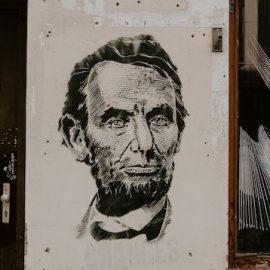
What did J. Robert Oppenheimer do after World War II? Were his political enemies successful?
Biographers Kai Bird and Martin Sherwin suggest that, after the war, Oppenheimer’s life was marked by his consistent advocacy for transparency and regulation in nuclear policy. Then, a politically motivated hearing effectively ousted him from the upper echelon of the US government.
Read more to learn what happened to Oppenheimer after the bomb.
The Aftermath of the Atom Bomb
President Truman chose to use the atomic bomb on Japan, bombing Hiroshima on August 6, 1945, and Nagasaki on August 9. According to Bird and Sherwin, Oppenheimer’s initial reaction to the bombings was ambivalent; he proudly congratulated his team following Hiroshima, but friends report him consumed with qualms. Oppenheimer, after the bomb, became an increasingly outspoken advocate for nuclear regulation, earning him powerful political opponents who sought to excommunicate him.
(Shortform note: To date, the bombings of Hiroshima and Nagasaki represent the only wartime uses of nuclear weapons. Since then, the closest the world has come to using nuclear weapons in combat was arguably in the Cuban Missile Crisis of 1962, in which the US and the Soviet Union nearly engaged in nuclear warfare at the peak of the Cold War.)
We’ll dig deeper into Oppenheimer’s life in the wake of the bombing.
Advocacy for Transparency and International Regulation
Following the bombings in Hiroshima and Nagasaki, Oppenheimer became increasingly vocal about atomic policy. As Bird and Sherwin relate, Oppenheimer’s proposed nuclear policy had two primary recommendations: The world should create an international commission to regulate nuclear weapons and scientists from all countries should speak freely with one another.
Bird and Sherwin write that Oppenheimer endorsed international regulation of nuclear energy in the Acheson-Lilienthal report to President Truman, a report written on behalf of Truman’s nuclear advisory committee in 1946. As the report’s author, Oppenheimer argued that all countries should submit to an international authority. He reasoned that an international body provided the best chance of avoiding nuclear war, as it would prohibit rogue nations from developing further nuclear weapons on their own.
Meanwhile, Bird and Sherwin say, in a November 1945 speech to Los Alamos scientists, Oppenheimer proposed creating a system that would allow different countries’ scientists to communicate openly. Such a system, he believed, would prevent countries from harboring secrets that could encourage a deadly nuclear arms race.
(Shortform note: Oppenheimer’s vision of an international body regulating atomic weapons was realized 11 years later, in 1957, with the creation of the International Atomic Energy Agency (IAEA). While the IAEA has many responsibilities, today, most of those responsibilities center around the enforcement of the 1968 Treaty on the Non-Proliferation of Nuclear Weapons, an international agreement that encourages the disarmament of nuclear weapons. Moreover, although no concrete system exists to encourage scientists of different countries to communicate, the IAEA also seeks to promote free exchange between member countries regarding the peaceful uses of nuclear energy.)
Oppenheimer’s Unsuccessful Attempts to Influence Nuclear Policy
Although Oppenheimer became an outspoken advocate of nuclear regulation, Bird and Sherwin maintain that he failed to successfully influence US nuclear policy. These failures were most obvious in two instances: Oppenheimer’s meeting with Truman and the Baruch Plan formed in response to Oppenheimer’s recommendations in the Acheson-Lilienthal Report.
Oppenheimer’s Meeting With Truman
Bird and Sherwin relate that, in October 1945, Oppenheimer earned a meeting with President Truman, providing him the opportunity to express his concerns about a potential arms race with the Soviet Union. However, Oppenheimer didn’t take full advantage of this opportunity, instead regretfully telling Truman “I feel I have blood on my hands”—a statement Truman took as a sign of weakness. Later, Truman allegedly commented, “I don’t want to see that son-of-a-bitch in this office ever again.”
(Shortform note: In Christopher Nolan’s blockbuster film, Oppenheimer, Nolan presents a slightly dramatized version of this meeting—in the movie, after President Truman ends the meeting, Oppenheimer hears Truman call him a “cry-baby scientist” to his aide. But, according to Bird and Sherwin, this detail was an embellishment. Truman did call Oppenheimer a cry-baby scientist, but only in a letter to Dean Acheson written months later.)
The Baruch Plan and the Acheson-Lilienthal Report
Bird and Sherwin also note that, as mentioned above, Oppenheimer was a key author of the Acheson-Lilienthal Report directed to President Truman. This sweeping report recommended full transparency with other nations and developing an international committee that reduced individual nations’ freedom to create nuclear weapons.
But, as Bird and Sherwin relate, President Truman’s representative to the United Nations (UN), Bernard Baruch, gutted the proposal. Instead, Baruch submitted his own plan to the UN that, according to Bird and Sherwin, specifically targeted the Soviet Union by rescinding their veto powers and stipulating that any violation of the agreement be punished with a nuclear bombing. In turn, the Soviets rejected Baruch’s plan, ultimately causing UN talks to stall and setting the stage for the coming Cold War.
(Shortform note: In the wake of the Baruch Plan’s failure, an arms race began that saw the US and the Soviet Union develop massive nuclear arsenals. Indeed, by 1975 the US and the Soviet Union together possessed 47,000 nuclear weapons, of which 27,000 belonged to the US and 20,000 to the Soviet Union. And even though both nations have disarmed significantly, the legacy of the arms race is noticeable today, with Russia and the US each having over 5,000 nuclear weapons in their arsenal—together almost 90% of the world’s nuclear weapons.)
The 1954 Security Clearance Hearing
Though Oppenheimer had spearheaded the creation of the atomic bomb and served on various committees consulting the government on nuclear policy, he was often targeted by his political enemies after the atomic bomb for his past connections to communism. According to Bird and Sherwin, the animosity toward Oppenheimer culminated in December 1953 when he learned that the Atomic Energy Commission (AEC) intended to revoke his security clearance.
The movement to revoke Oppenheimer’s security clearance, Bird and Sherwin argue, was led by Lewis Strauss—the chairman of the AEC. Bird and Sherwin write that Strauss’s disdain of Oppenheimer was deep-seated; in his 1949 testimony before the Joint Committee on Atomic Energy, Oppenheimer had embarrassed Strauss by sharply refuting Strauss’s testimony about the importance of isotopes in developing nuclear weapons.
After many confrontations with Oppenheimer about nuclear policy in the early 1950s, Strauss began plotting to get Oppenheimer’s security clearance revoked. According to Bird and Sherwin, he first contacted William Borden, the AEC’s staff director who felt similarly about Oppenheimer and provided Borden access to Oppenheimer’s security file. On the basis of this file, Strauss helped Borden compose a brief alleging Oppenheimer was likely a Soviet agent. Bird and Sherwin say that this brief led to an FBI report that convinced the Eisenhower administration to conduct an AEC hearing to revoke Oppenheimer’s security clearance.
Strauss’s Illicit Tactics Throughout the Hearing
As the AEC’s chairman, Strauss had the authority to decide the three members of the AEC panel that would judge Oppenheimer. In addition to this authority, Bird and Sherwin argue, Strauss consistently employed illicit tactics throughout the hearing to predetermine the verdict against Oppenheimer.
Tactic #1: Biasing the Board
First, Bird and Sherwin point out that even before the hearing, Strauss actively biased the panel against Oppenheimer. They write that Strauss arranged for the panel members to read Oppenheimer’s FBI security file before the hearing—in the presence of prosecuting attorney Roger Robb, at that. Without Oppenheimer’s defense present, Robb personally guided the board through the most damning portions of Oppenheimer’s security file. As Bird and Sherwin relate, this violated the basic legal principle of tabula rasa—that juries approach trials with a clean slate and no preconceived opinions of the defendant.
Tactic #2: Handicapping Oppenheimer’s Lawyers
Further, Bird and Sherwin observe that Strauss handicapped Oppenheimer’s lawyers by denying them a security clearance while providing one for the prosecuting lawyers. As a result, Oppenheimer’s lawyers often lacked access to the evidence presented to the panel, making it impossible for them to respond to the prosecution’s accusations.
Tactic #3: Illegal FBI Wiretaps
Finally, Bird and Sherwin write that Strauss had access to illegal FBI wiretaps of Oppenheimer’s conversations with his lawyers. As a result, Strauss could predict the defense lawyers’ legal tactics and relay them to Robb, the prosecuting attorney. These illegal wiretaps not only violated attorney-client privilege but also provided Robb with a strategic edge throughout the hearing.
The Presentation of the Chevalier Incident
Bird and Sherwin contend that, in addition to underhanded tricks, the prosecution relied heavily on Oppenheimer’s testimony about the “Chevalier incident,” a conversation between Oppenheimer and Haakon Chevalier, his close friend and fellow Berkeley faculty member, in late 1942.
Months later, in August 1943, Oppenheimer first gave an account of this conversation to Colonel Boris Pash. Oppenheimer told Pash that he and two other scientists had been approached by an intermediary (later revealed as Chevalier) who was friends with George Eltenton, a physicist with connections to the Soviet Union. Per Oppenheimer’s testimony, this intermediary told Oppenheimer and the other scientists that Eltenton hoped to relay information about the Manhattan Project to the Soviets, a suggestion Oppenheimer immediately called treasonous.
Later, in June 1946, FBI agents simultaneously interviewed Eltenton and Chevalier about Chevalier’s discussion with Oppenheimer in 1943, giving them no time to coordinate their answers. They both corroborated Oppenheimer’s previous account, with one glaring exception: They both denied having approached two other scientists, as Oppenheimer claimed. Later, in September 1946, FBI agents interviewed Oppenheimer himself, who admitted to fabricating elements of his original account to protect Chevalier’s identity.
Bird and Sherwin point out that, in the 1954 hearing, Oppenheimer’s prior false testimony proved damning. Robb compelled Oppenheimer to admit to the AEC’s panel that he had lied to the FBI and waited eight months to disclose a conversation of crucial security information. Moreover, in the heat of the examination, Robb induced Oppenheimer to call himself “an idiot” who told “a whole fabrication and tissue of lies.” This testimony, Bird and Sherwin argue, greatly discredited Oppenheimer in the eyes of the panel.
The AEC Panel’s Ruling
Strauss’s efforts to revoke Oppenheimer’s security clearance proved successful in May 1954: The panel voted two to one to revoke Oppenheimer’s security clearance, deeming Oppenheimer a security risk (though affirming his loyalty to the US). Bird and Sherwin argue that the dissent, written by Ward Evans, captured the true nature of the hearing: It pointed out that nearly all the evidence in the hearing was known in 1947 when Oppenheimer’s security clearance was renewed by the AEC. For this reason, Evans thought there was no justification for revoking Oppenheimer’s clearance years later. And, although the ruling was technically a recommendation, Bird and Sherwin note that it was ratified by AEC commissioners in a four-to-one vote in June 1954.
Exercise: Assess Oppenheimer’s Views and Influence
Bird and Sherwin maintain that Oppenheimer’s creation of the atomic bomb had ripples down the line, all the way to the present day. In this exercise, reflect on Oppenheimer’s views and the impact his views have had on nuclear weapons in contemporary society.
- How worried are you about nuclear weapons and their impact on the modern world? Why?
- To what extent do you agree with Oppenheimer that international regulation of nuclear weapons is desirable? Explain your answer.
- To what extent do you agree that transparency among scientists studying nuclear energy is desirable? Again, explain your answer.
- How do your own country’s nuclear policies align with Oppenheimer’s views on transparency and international regulation? Answering this question might involve, for instance, researching whether your country participates in the International Atomic Energy Agency.






